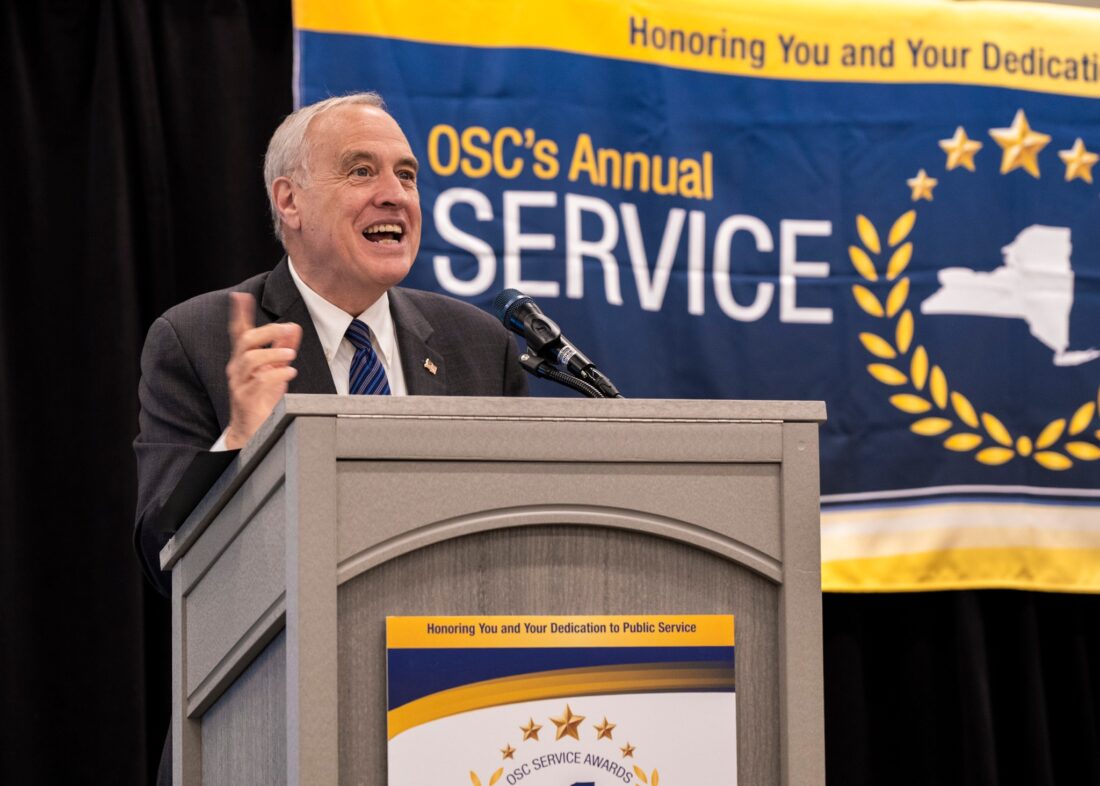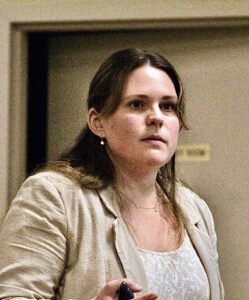DiNapoli: State Faces $34.3B Budget Gap

State Comptroller Thomas DiNapoli is pictured speaking to Comptroller’s Office employees earlier this year. DiNapoli is warning of looming budget gaps created by the potential for declining state revenues, rising state spending and federal spending cuts.
State Comptroller Thomas DiNapoli is sounding the alarm on what could be the biggest state budget gaps since the 2009 recession.
The state’s Financial Plan shows a growing structural budget deficit with a cumulative three-year budget gap of $34.3 billion, as forecasted by the state Division of the Budget. When accounting for recent federal actions, the gaps as a share of spending reach levels not seen since the Global Financial Crisis of 2009, according to DiNapoli’s report on the state’s 2026 Enacted Budget and First Quarterly Financial Plans. The $34.3 billion gap is up $7 billion since the January release of Gov. Kathy Hochul’s 2026 Executive Budget Financial Plan, and is attributable to downward revisions to the economic forecast and projected revenues, as well as increases in projected spending.
“The financial plan paints a challenging picture for the state that will only grow more problematic with the incoming federal cuts from the reconciliation bill signed by the president,” DiNapoli said. “This is likely just the beginning; the relationship between the federal government and the states is being restructured, and state governments will be facing drastic reductions in federal aid that could force difficult decisions about state revenue and spending priorities. There is an urgent need to formulate a fiscal response to the federal reconciliation bill and support New York’s safety net.”
Hochul recently told state agency heads to find a total of $750 million in cuts to their budgets to offset federal spending cuts. The governor said on MSNBC last week that the cuts for the rest of 2025 come to about $750 million and increase to about $3 billion in 2026 in programs that include health care and SNAP benefits.
“We have to make up $750 million right now. I’m saying, “Go back to your agencies, find some cuts, find out what we can save some money.” Next year, I have a $3 billion cut. We’ll get together with the Legislature, try to work it out, but this is grotesquely unfair, not just to the states, but to the people we serve,” Hochul said.
DiNapoli’s report suggests Hochul and department heads go further. The comptroller said the state must look at the potential for implementing efficiencies by streamlining operations and improving internal controls, finding savings across all state operations and local assistance programs, analyzing performance, service and economic data to assess which programs – both those that provide services and those that provide tax credits – are most effective and identifying those which are duplicative, ineffective or cost-inefficient; and keeping tax rates competitive at a time when New Yorkers are facing growing affordability challenges.
GROWING GAPS
Spending in the 2026 budget is projected to total $254.4 billion while revenues are $249.2 billion. State Operating Funds disbursements are projected to grow by $12.4 billion (9.3%) and General Fund disbursements by $16.8 billion (15.5%) in 2026. State Operating Fund spending growth is estimated to be 13.9% over the Financial Plan period, outpacing projected SOF revenue growth of 4.6%, DiNapoli said.
Higher spending growth in school aid and Medicaid has driven overall spending growth. In addition to being the largest areas of spending, they have also grown the fastest, according to DiNapoli. Between 2016 and 2026, State Operating Fund spending is projected to grow 55%. Health Department and Other Agency Medicaid spending is projected to grow nearly 120% over the 10-year period while school aid is projected to grow 58.7%.
On an All Funds basis, the state Division of Budget projects Medicaid spending will total almost $112.2 billion in 2026, which would represent 44.1% of projected All Funds disbursements for the year. When spending on the Essential Plan is included — estimated to be $13.7 billion in 2026 — these two healthcare programs are projected to comprise almost 50% of All Funds disbursements.
NOT JUST A SPENDING PROBLEM
The economic forecast published with the Financial Plan was revised downwards from the projections made with the Consensus Forecast report on March 1. Job gains both nationally and statewide slowed through May. Average monthly employment growth in New York was 4,600 jobs, down from 19,100 for the same period last year. For the current fiscal year, the Division of Budget is projecting a weaker New York economy with both wage and personal income growth forecasted to decelerate from their previous fiscal year levels.
Federal receipts are projected to decline by $2.6 billion in 2026 largely due to waning federal pandemic relief funds. Spending reductions recently enacted for federal fiscal year 2025 and currently being negotiated for 2026 in Congress are not included in the state Division of Budget projections. Based on DOB’s estimates, the Financial Plan is projected to become more reliant on state tax revenues; by 2029, tax collections are projected to account for nearly half of total revenues. Of the state’s individual tax sources, over 50% come from the Personal Income Tax.
IMPACT OF FEDERAL ACTIONS
The Enacted Budget Financial Plan was released prior to the enactment of federal budget legislation signed by President Donald Trump on July 4. The federal bill implements deep cuts to federal funding and changes to eligibility for safety net programs, which will have major impacts on the state’s Financial Plan.
In the first quarter update to the financial plan released in July, Hochul and the Division of Budget estimate between $3 to $5 billion in costs to state and local governments as a result of the federal bill. The update indicates the federal budget law will have a $750 million state impact in 2026 and impacts ranging between $3 billion and $3.4 billion in subsequent years on the financial plan, but did not adjust estimates of receipts, disbursements and budget gaps for these estimates.
Analysis by the Office of the State Comptroller based on information currently available indicates the early impacts of spending provisions of the federal budget bill will result in lost federal receipts between $27 and $29.6 billion over the Financial Plan period. Programs affected include aid for food programs, climate, clean energy, and resiliency programs, many of which were approved under the Inflation Reduction Act.
RESERVE FUNDS
The Financial Plan indicates that the state’s principal reserve levels will decrease by $7.5 billion (34.7%) to $14.1 billion in 2026 and remain at that level throughout the Financial Plan period, with the only change being shifts from the informal “economic uncertainties” reserve into the Rainy Day Reserve Fund. No increases in principal reserves are planned for the Financial Plan period. If continued deposits are made as currently projected in the Financial Plan, the statutory rainy day reserve funds would total $11.6 billion by 2029.
DiNapoli also raised warnings over the state’s use of debt to finance its essential capital needs is appropriate, but its overreliance on bonds, in particular backdoor borrowing through public authorities, has led to one of the highest debt burdens in the nation. Total state-supported debt outstanding is projected to grow over 70% during the next five years, from $55.9 to $95.1 billion. As a result, the state is projected to near its debt limit, with room under the state’s debt cap projected to decline to just $503 million by 2030. Approaching the debt cap would mean that future projects might have to be delayed and it will be more difficult for the state to both keep existing infrastructure in a state of good repair and make infrastructure investments to move the state forward.





